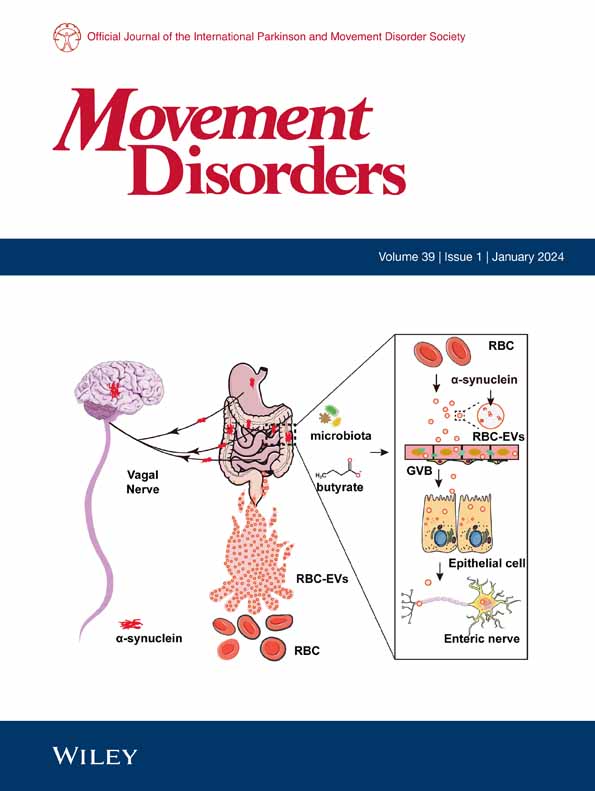Treatment Efficacy of Theophylline in ADCY5‐Related Dyskinesia: A Retrospective Case Series Study
IF 7.4
1区 医学
Q1 CLINICAL NEUROLOGY
引用次数: 0
Abstract
BackgroundADCY5‐related dyskinesia is a rare disorder caused by mutations in the ADCY5 gene resulting in abnormal involuntary movements. Currently, there are no standardized guidelines to treat this condition.ObjectiveThe aim of this study was to evaluate the efficacy of theophylline administration in improving symptoms and quality of life in patients with ADCY5‐related dyskinesia.MethodsA retrospective study was conducted involving 12 patients (aged 2–41 years) with ADCY5‐related dyskinesia. Participants completed a questionnaire about theophylline administration, including dosage, improvement of symptoms, adverse effects, and changes in quality of life. Data were analyzed for reported efficacy and side effects.ResultsTheophylline administration demonstrated substantial efficacy, with 92% (11 of 12) of patients reporting significant improvements in their movement disorders. The average improvement score was 7.0 ± 1.9 (mean ± SD) on a 10‐point scale. Notable improvements included reductions in severity and frequency of episodes, improved gait, more independent mobility, psychosocial well‐being, and quality of sleep. Adverse effects were reported by 6 patients, including dystonia, worsening of speech, headaches, nausea, impaired sleep, and agitation.ConclusionsTheophylline shows substantial promise as a treatment option for ADCY5‐related dyskinesia, improving various aspects of patients' quality of life and movement disorder symptoms. Further research is needed to optimize dosing, to understand long‐term effects, and to explore combinational drug therapies. Despite the small cohort size and the retrospective nature of this study, the results support theophylline administration to decrease dyskinetic movements and enhance overall quality of life in patients. © 2025 The Author(s).茶碱治疗ADCY5相关运动障碍的疗效:回顾性病例系列研究
ADCY5相关运动障碍是一种罕见的由ADCY5基因突变引起的不自主运动异常的疾病。目前,没有标准化的指导方针来治疗这种情况。目的本研究的目的是评估茶碱治疗对改善ADCY5相关运动障碍患者症状和生活质量的疗效。方法对12例ADCY5相关运动障碍患者(年龄2-41岁)进行回顾性研究。参与者完成了一份关于茶碱给药的问卷,包括剂量、症状改善、不良反应和生活质量的变化。对报告的疗效和副作用进行数据分析。结果茶碱治疗显示出显著的疗效,92%(12名患者中的11名)的患者报告其运动障碍有显著改善。在10分制中,平均改善得分为7.0±1.9 (mean±SD)。显著的改善包括严重程度和发作频率的降低、步态的改善、更独立的活动能力、社会心理健康和睡眠质量。6例患者报告了不良反应,包括肌张力障碍、言语恶化、头痛、恶心、睡眠障碍和躁动。结论茶碱作为ADCY5相关运动障碍的一种治疗选择,在改善患者生活质量和运动障碍症状的各个方面显示出巨大的希望。需要进一步的研究来优化剂量,了解长期效应,并探索联合药物治疗。尽管这项研究的队列规模较小,而且是回顾性的,但结果支持茶碱治疗可以减少患者的运动障碍,提高患者的整体生活质量。©2025作者。Wiley期刊有限责任公司代表国际帕金森和运动障碍学会出版的《运动障碍》。
本文章由计算机程序翻译,如有差异,请以英文原文为准。
求助全文
约1分钟内获得全文
求助全文
来源期刊

Movement Disorders
医学-临床神经学
CiteScore
13.30
自引率
8.10%
发文量
371
审稿时长
12 months
期刊介绍:
Movement Disorders publishes a variety of content types including Reviews, Viewpoints, Full Length Articles, Historical Reports, Brief Reports, and Letters. The journal considers original manuscripts on topics related to the diagnosis, therapeutics, pharmacology, biochemistry, physiology, etiology, genetics, and epidemiology of movement disorders. Appropriate topics include Parkinsonism, Chorea, Tremors, Dystonia, Myoclonus, Tics, Tardive Dyskinesia, Spasticity, and Ataxia.
 求助内容:
求助内容: 应助结果提醒方式:
应助结果提醒方式:


